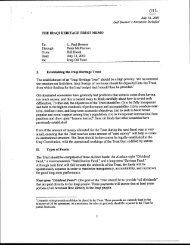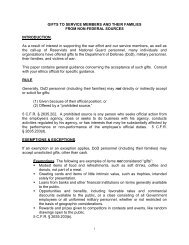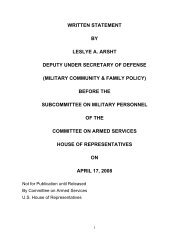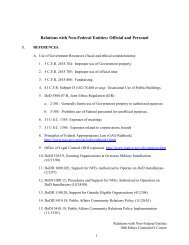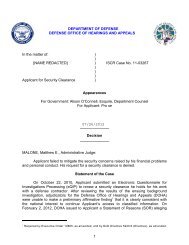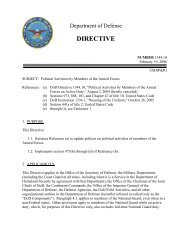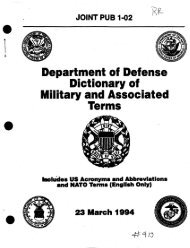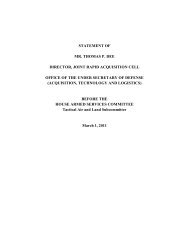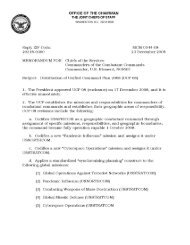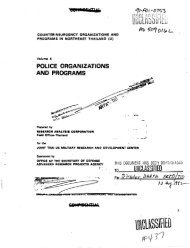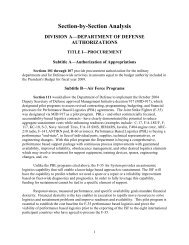dod tactical herbicide sites - United States Department of Defense
dod tactical herbicide sites - United States Department of Defense
dod tactical herbicide sites - United States Department of Defense
You also want an ePaper? Increase the reach of your titles
YUMPU automatically turns print PDFs into web optimized ePapers that Google loves.
and those who participated in Operation PACER HO, may have received a “measureableexposure” to TCDD. This was most likely true even though participants were generallyinstructed to use face shields or respirators, rubber gloves, and aprons. Many <strong>of</strong> thesestudies were conducted in subtropical and tropical climates; the wearing <strong>of</strong> protectiveclothing was very uncomfortable. In Operation PACER HO great care was taken tomonitor the safety <strong>of</strong> the hundreds <strong>of</strong> men who participated in the de-drumming andtransfer <strong>of</strong> the liquid Herbicide Orange and rinse, but the process was not free <strong>of</strong> minorspills and accidents.Although most <strong>of</strong> the studies on the disposal options for Herbicide Orange involvedActive Duty military, the use <strong>of</strong> safety protocols was an important part <strong>of</strong> the studies, andthey were less likely to be exposed to the liquid Herbicide Orange. Safety protocols werealso required in the site monitoring and remediation programs that followed PACER HOat the Naval Construction and Battalion Center and at Johnston Island. Active Dutymilitary personnel handled contaminated soil. Studies <strong>of</strong> the binding <strong>of</strong> TCDD to soilparticles likely minimized the cutaneous availability to naked skin (e.g., hands) and tomany biological organisms associated with that soil [10,11]. Moreover, The handling <strong>of</strong>these soils generally occurred many months to years after the soil had been contaminatedand most the residues would have been degraded by chemical and biological mechanisms[12]. Nevertheless, it cannot be concluded that “no measurable exposure” occurred.Indeed, three <strong>of</strong> the individuals who had participated in these monitoring programs didhave analyses <strong>of</strong> their adipose tissue performed in 1978, and levels <strong>of</strong> 5-7 parts-pertrillion(ppt) TCDD were measured [10]. RANCH HAND personnel who handled theliquid Herbicide Orange a decade before the above individuals still had in 1986 levelsthat were orders <strong>of</strong> magnitude greater than those involved in the monitoring programs [8].References[1] Young AL, Giesy JP, Jones PD, Newton M (2004): Environmental Fate andBioavailability <strong>of</strong> Agent Orange and Its Associated Dioxin During the Vietnam War.ESPR – Environ Sci & Pollut Res 11 (6): 359-370[2] Crosby DG, Wong AS (1977): Environmental Degradation <strong>of</strong> 2,3,7,8-Tetrachlorodibenzo-p-dioxin(TCDD). Science 195: 1337-1338[3] Harris SA, Solomon KR (1992): Percutaneous Penetration <strong>of</strong> 2,4-DichlorophenoxyaceticAcid and 2,4-Dimethylamine Salt in Human Volunteers. J Toxicol Environ Health36 (3): 233-240[4] Newton M, Norris LA (1981): Potential Exposure <strong>of</strong> Humans to 2,4,5-T and TCDD inOregon Coast Range. Fund Appl Toxicol 1: 339-346[5] Lavy TL (1987): Human Exposure to Phenoxy Herbicides. VA Monograph, May1987, Agent Orange Projects Office, <strong>Department</strong> <strong>of</strong> Medicine and Surgery, VeteransAdministration Central Office, Washington, DC, 128 pages[6] Hood RD (1985): Cacodylic Acid: Agricultural Uses, Biologic Effects, andEnvironmental Fate. VA Monograph, December 1985, Agent Orange Projects Office,<strong>Department</strong> <strong>of</strong> Medicine and Surgery, Veterans Administration Central Office,Washington, DC, 171 pages78



